The Blinking Planetary Nebula is a planetary nebula located approximately 2,000 light-years away in the northern constellation Cygnus. It is also known as the Blinking Eye Nebula. With an apparent magnitude of 8.8, the nebula can be observed in amateur telescopes. It has the designation NGC 6826 in the New General Catalogue and Caldwell 15 (C15) in the Caldwell catalogue.
The Blinking Planetary Nebula has an apparent size of 27 by 24 arcseconds and lies in the region of the Northern Cross, one of the most familiar asterisms in the northern sky. Like all planetary nebulae, it formed when an aging red giant star reached the end of its life and expelled its outer gaseous envelope into space. The cloud of gas and dust is illuminated by the hot stellar remnant, which will eventually cool and fade as a dense white dwarf.
The central star of the Blinking Planetary Nebula has the stellar classification O6fp, indicating a very hot blue star. It is one of the brightest central stars detected in a planetary nebula.
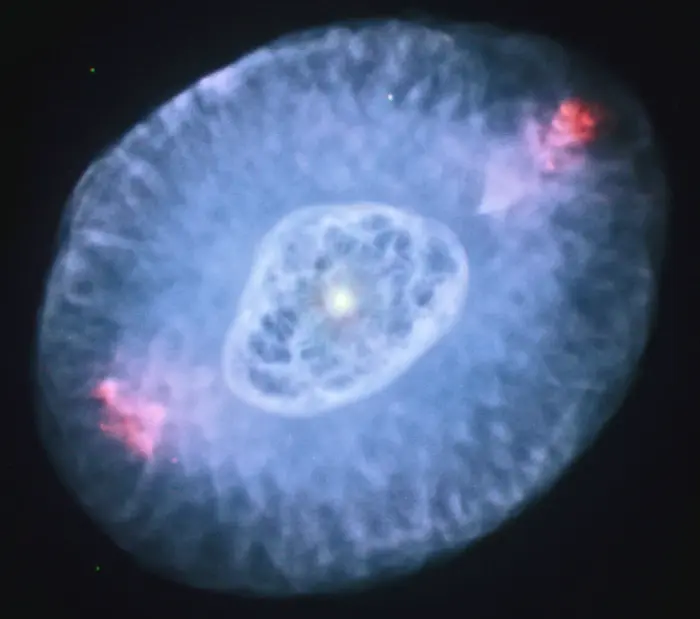
Blinking Planetary Nebula (NGC 6826), image: Judy Schmidt (CC BY 2.0)
The nebula’s name comes from its appearance in small telescopes. Likely many other nebulae, NGC 6826 exhibits blinking. The brightness of the planetary nebula nucleus (PNN) overwhelms the observer’s eye when seen directly because the central star is much brighter than the nebula. When viewed through the eyepiece of a telescope, the star obscures the fainter surrounding nebulosity. However, the nebula can be observed using averted vision. When seen with peripheral vision – looking to the side or to the edge of the field of view – while concentrating on the object, the nebula appears to “blink” in an out of view as the observer’s eye wanders.
The Blinking Planetary Nebula contains two bright patches on either side. These are known as FLIERS (Fast Low-Ionization Emission Regions), volumes of gas with low ionization that move at supersonic speeds.
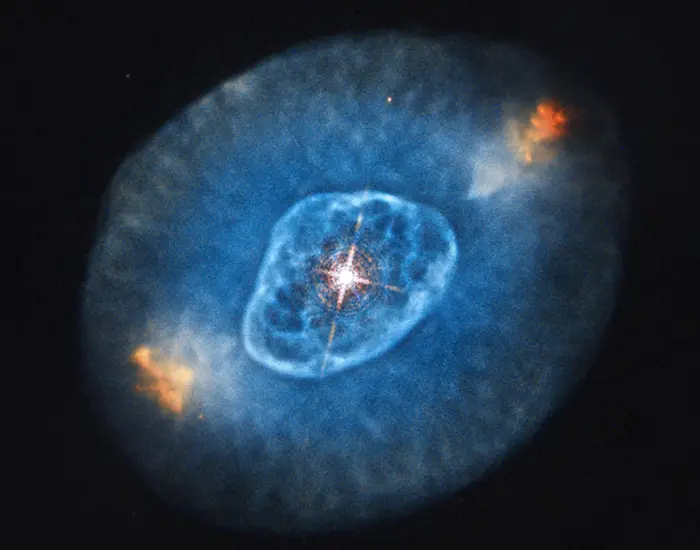
Blinking Planetary Nebula (Caldwell 15), image: NASA
FLIERS are typically found near a planetary nebula’s axis of symmetry. They have much lower ionization than the rest of the nebula and much higher outflow speeds. The higher speeds suggest that they are much younger than the rest of the nebula. They were flung outward by the central star only recently, about a thousand years ago. The low ionization indicates that the ultraviolet radiation from the central star, which ionizes the nebula’s gas, does not permeate the FLIERS. Even though they are not an uncommon feature of planetary nebulae, the formation of FLIERS is still not well understood.
NGC 6826 is surrounded by a large faint halo that stretches beyond the brighter central ring. The halo consists of material ejected by the central star before the main nebula was formed.
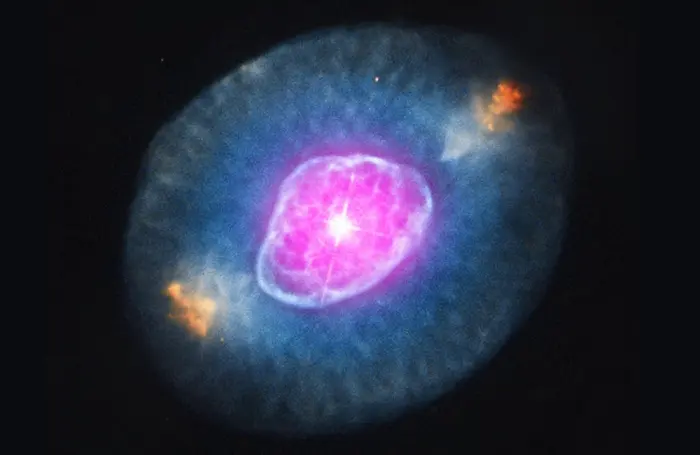
Blinking Planetary Nebula, image: NASA
Facts
The Blinking Planetary Nebula was discovered by the German-born British astronomer William Herschel on September 6, 1793. Herschel catalogued the object as IV 73 in his Catalogue of 500 New Nebulae, Nebulous Stars, Planetary Nebulae, and Clusters of Stars; With Remarks on the Construction of the Heavens, published in the Philosophical Transactions of the Royal Society of London in 1802.
Herschel noted, “A bright point, a little extended, like two points close to one another, as bright as a star of the 8.9 magnitude, surrounded by a very bright milky nebulosity suddenly terminated, having the appearance of a planetary nebula with a lucid centre; the border however is not very well defined. It is perfectly round, and I suppose about half a minute in diameter. It is of a middle species, between the planetary nebulae and nebulous stars, and is a beautiful phenomenon.”
The Blinking Planetary Nebula was first imaged by the Hubble Space Telescope in January 1996. The image was taken with the Wide Field and Planetary Camera 2. It revealed the two FLIERS and the hot central star surrounded by a hot inner bubble and another bubble formed of older material.
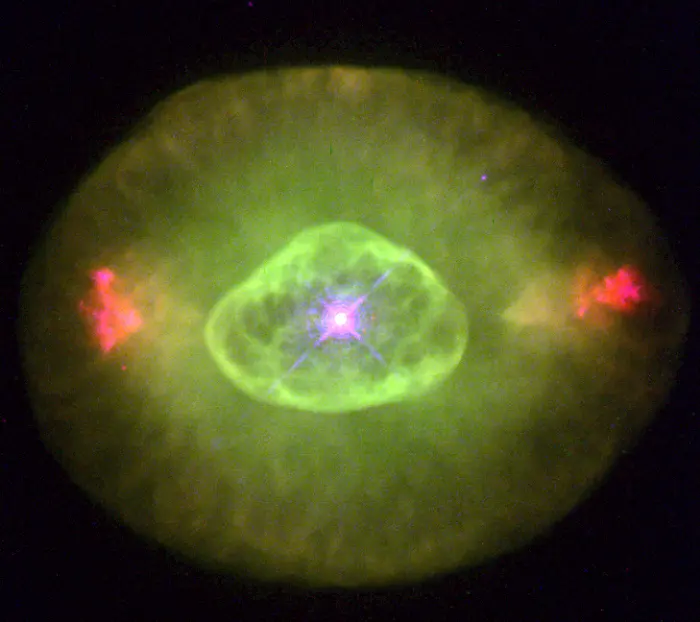
When observers look directly at Caldwell 15 through a small telescope, they typically see only the nebula’s sparkling-white central star. However, by averting one’s gaze, glancing away from the central star, the nebula’s bulbous dust clouds come into view. This optical trickery earned this planetary nebula the name “the Blinking Planetary.” The Blinking Planetary’s bright, white remnant star — known as a white dwarf — is surrounded by a greenish orb of gas and dust, the outer layers of the burned-out star that jettisoned into space. This cloud is flanked on both sides by bursts of red gas called FLIERS, or fast low-ionization emission regions. In these relatively young features, electrically charged atoms shoot off into space at supersonic speeds. This image of Caldwell 15 was captured by Hubble’s Wide Field and Planetary Camera 2 in January 1996 to help astronomers better understand how the nebula’s FLIERS form. Image credit: Bruce Balick (University of Washington), Jason Alexander (University of Washington), Arsen Hajian (U.S. Naval Observatory), Yervant Terzian (Cornell University), Mario Perinotto (University of Florence, Italy), Patrizio Patriarchi (Arcetri Observatory, Italy) and NASA (CC BY 2.0)
Location
The Blinking Planetary Nebula appears in the region of the Swan’s wing, not far from Fawaris (Delta Cygni), one of the stars that form the Northern Cross. It lies just southeast of the magnitude 3.77 star Iota Cygni, in the direction of Deneb, along the imaginary line extended from Alderamin in the constellation Cepheus to Delta2 Lyrae, one of the stars that form a parallelogram near Vega in Lyra.
Iota Cygni is the brightest star roughly halfway between Alderamin and Vega. The bright Vega forms the Summer Triangle with Deneb and Altair, and Alderamin can be found by extending a line from the rightmost stars of Cassiopeia’s W (Schedar and Caph).
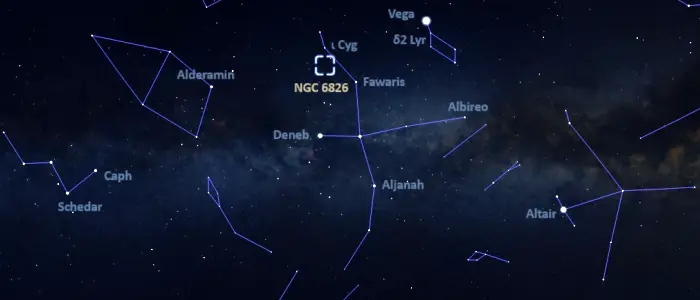
The location of the Blinking Planetary Nebula, image: Stellarium
The best time of the year to observe the Blinking Planetary Nebula and other deep sky objects in Cygnus is during the month of September, when the constellation is high above the horizon in the evening. For observers in the northern hemisphere, Cygnus is prominent throughout the summer months.
At declination +50°, the nebula is visible from locations north of the latitude 40° S. For observers in the southern hemisphere, it always appears in the northern sky.
Blinking Planetary Nebula – NGC 6826
| Constellation | Cygnus |
| Right ascension | 19h 44m 48.1500225888s |
| Declination | +50° 31′ 30.249034932″ |
| Apparent magnitude | 8.8 |
| Apparent size | 27″ × 24″ |
| Distance | 2,000 light-years |
| Radius | 0.22 x 0.20 light-years |
| Names and designations | Blinking Planetary Nebula, NGC 6826, Caldwell 15, PK 083+12 1, ARO 13, VV’ 514, VV 242, PN G083.5+12.7, HD 186924, SAO 31951, AG+50 1416, BD+50 2869, DO 37693, IRAS 19434+5024, 2MASS J19444815+5031303, TYC 3565-205-1, Gaia DR2 2135352396915239808, Gaia DR3 2135352396915239808 |